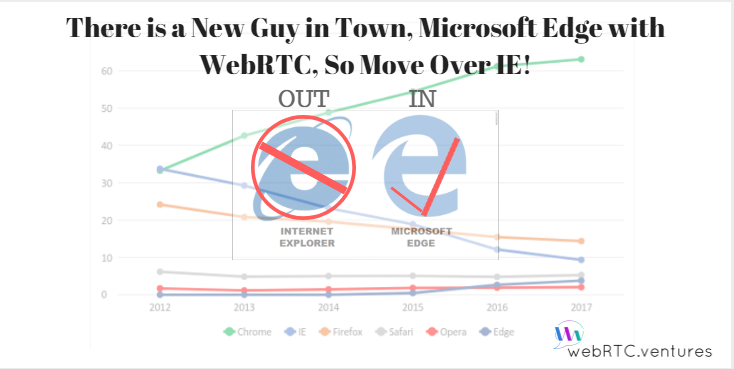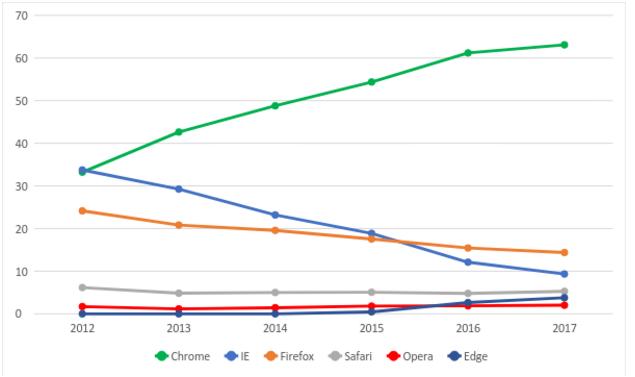Today, I think we can all agree that communication is very interactive. We are not only becoming more visual, but want things FAST, in real-time. Internet Explorer is losing popularity and Microsoft Edge Windows 10 with WebRTC features is gaining much attention.
Here’s why!
In the past, we were reliant solely on vocal and video communications. Several projects and software products were released to provide us the real-time communication with main components being chat, voice, video and screenshare. The main feature in all these products was that each had its own proprietary implementation.
But, today’s society wants and expects the ability to communicate at any given moment. Luckily, in the cloud era, when the browser is the platform base to access all our tools, we are offered visual communication components such as text editors, spreadsheets, email, shared folders, social medias, and more.
Not only do we want the aforementioned additional communication tools, but we want it fast. Like in webRTC (real-time communications over the web) fast and we wan t to use browsers that support webRTC.
The W3C was adopting a solution called WebRTC, it standardizes the support for real-time capabilities in the modern browsers.
Looking the Desktop Browser Market Share Worldwide in the five previous years, it is evident the Chrome become in the number one Browser, and it is followed by Firefox. Please see the below chart:
These browsers are being implemented the support for WebRTC in different stage like:
- Firefox released the support to WebRTC in Q4, 2011
- Chrome released the preview WebRTC in January 2012
The above chart shows us the Internet Explorer is losing popularity day-by-day. Maybe, the main reason why IE is losing popularity is that it does not provide any signal support to the ever growing in popularity WebRTC? Again, as a technologically advanced society, we want fast, real-time communication abilities. Features that include voice, video, chat, file and screen share. We want AND expect this in both our personal and business interactions (also why so many businesses are jumping onboard the webRTC bandwagon!)
The chart also shows that Microsoft Edge webRTC is growing in popularity. It is currently is in the fifth position with 3.96% of market share, and with a good tendency to increase. Another point to consider is Windows on a whole has 83.53% of the market Share and Windows 10 is around 25%.
I think, those are the main reasons that Microsoft announced in early 2017 the support of WebRTC in Edge of Windows 10 more concreted from Windows 10 version 15019.
The features included are:
- WebRTC – WebRTC v1.0 API
- VP8 for RTC*
- H.264/AVC for RTC*
*The two bottom points are showing a must in contrast with the two major browsers, and taking the words of Microsoft:
“The H.264/AVC and VP8 video codecs are supported in the Microsoft Edge RTC stack, which means video communications are now interoperable between Microsoft Edge and other major WebRTC browsers and RTC services. We have implemented the following congestion control and robustness mechanisms for both H.264/AVC and VP8 video codecs:
- Support for the absolute send time header extension (abs-send-time)
- Support for Google Receiver Estimated Maximum Bitrate, “goog-remb”
- Support for Picture Loss Indication (PLI) and Generic NACK feedback messages, per RFC 4585
- Support for RTP Retransmission, per RFC 4588
These features are available within both the ORTC API and native WebRTC 1.0 API, so you can make API and video codec decisions independently.
Note that while the Edge H.264/AVC implementation supports hardware offload within both the encoder and decoder, VP8 is implemented purely in software, and as a result may exhibit higher power consumption and CPU load. If your application uses VP8, we recommend testing on lower-end devices to ensure acceptable performance.”
In conclusion, in our current era, when all our tools are in the cloud, our communication tools would not require third party tools to work. Except our favorite browsers, like Microsoft, is working in Edge to include the support of WebRTC.
Another point to take into account, the interoperability among our favorite browsers, we would not require use the same browser to use the WebRTC tools, those should work perfectly among different browsers
Hopefully, in the near future in different platform, including desktops and mobiles, and in this last platform Android is the king, but, Microsoft is working of the hand of Qualcomm to have best support of Windows 10 in mobile processors.
[kleo_divider type=”full|long|double|short” double=”yes|no” position=”center|left|right” text=”” class=”” id=””]
Our team at WebRTC.ventures can build your custom-designed real-time communications application! Please click here to learn about some of our work and the areas we often serve. Then contact us to discuss your application needs!












